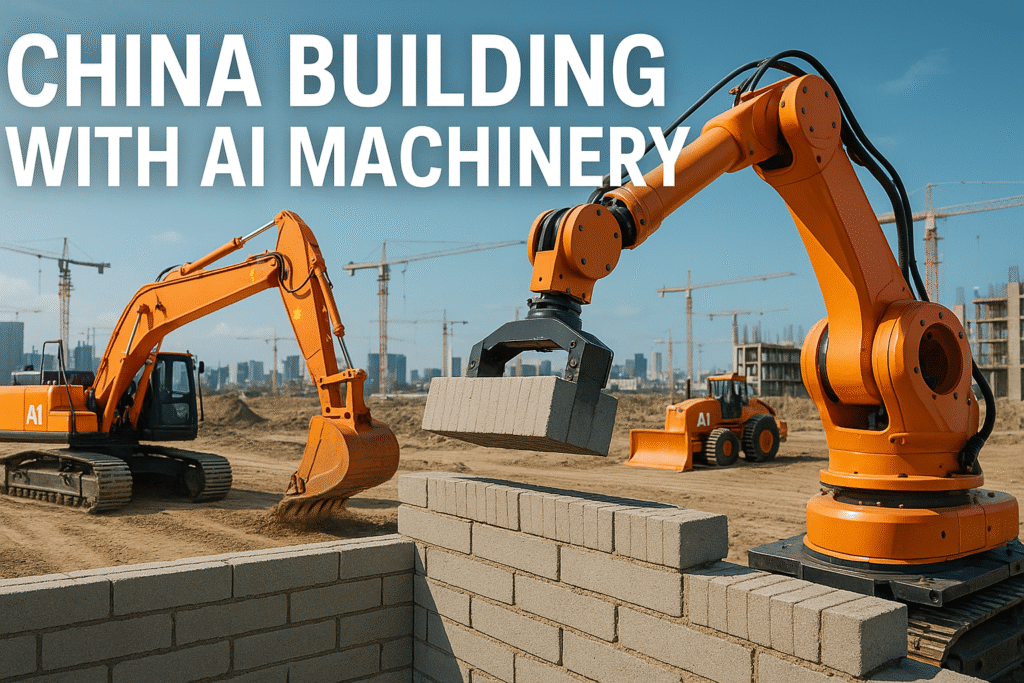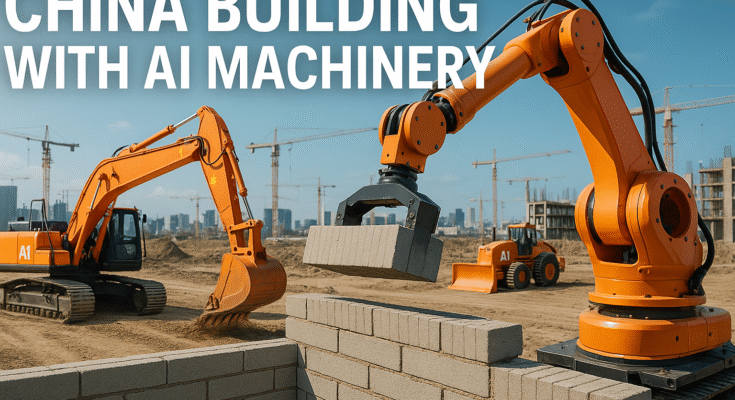
China is leading the world in using AI machinery for construction Revolutionizing Construction with Technology
Introduction
The integration of artificial intelligence (AI) in the construction industry is transforming the way buildings are planned, designed, and constructed across the globe. At the forefront of this transformation is China, a country known for its rapid urban development and technological advancements. Today, “China building with AI machinery” is not just a futuristic idea; it’s a present-day reality reshaping the construction landscape.
In this article, we’ll explore how AI-powered machinery is being used in China’s construction sector, its benefits, challenges, and the future implications for both China and the rest of the world.
What Is AI Machinery in Construction?
Before diving into China’s implementation, it’s essential to understand what AI machinery means in the construction industry. AI machinery refers to intelligent construction equipment and automated systems that utilize machine learning, computer vision, robotics, and real-time data to perform tasks that previously required manual labor.
Examples include:
- AI-powered excavators and bulldozers
- Robotic bricklayers
- 3D printing machines for concrete structures
- Drones for site surveying and monitoring
- Predictive maintenance tools for heavy equipment
China’s Vision for AI in Construction
China has outlined its ambition to become a global leader in AI by 2030. This includes deploying AI in multiple sectors, with construction being a primary focus. As urban populations grow, the demand for smart cities and infrastructure development has intensified. To meet this demand, China is turning to AI-driven solutions that promise efficiency, accuracy, and reduced costs.
Real-World Applications of AI Machinery in China
1. AI-Powered 3D Printing of Buildings
One of the most groundbreaking examples of China building with AI machinery is the use of 3D printing. Chinese companies like WinSun have already constructed entire villas and office buildings using AI-guided 3D printers. These printers use a special concrete mixture and build layer-by-layer, significantly reducing material waste and labor costs.
2. Autonomous Construction Vehicles
Companies such as XCMG and SANY are pioneering the development of autonomous bulldozers, cranes, and road rollers. These machines use AI and sensors to perform tasks like leveling land, laying foundations, and paving roads with minimal human input.
3. AI for Safety Monitoring
China is deploying AI-powered surveillance systems at construction sites to monitor worker behavior, detect potential hazards, and enforce safety compliance. These systems analyze video footage in real-time and can send alerts if a worker isn’t wearing a helmet or if unsafe practices are detected.
4. Smart Project Management
AI is being used to improve construction project timelines. Tools powered by machine learning analyze historical data to predict project delays, budget overruns, and suggest more efficient workflows. For example, Alibaba Cloud offers AI-based construction project management tools now widely used in Chinese mega-projects.
Benefits of Using AI Machinery in China’s Construction Industry
1. Increased Efficiency
AI machinery can work 24/7 without fatigue, increasing the speed of construction and reducing project completion times.
2. Cost Savings
Although initial investments in AI equipment can be high, long-term savings are significant due to reduced labor costs, minimal material waste, and fewer errors.
3. Enhanced Precision
AI and robotics bring a level of precision that surpasses human capability, resulting in stronger, safer, and more aesthetically pleasing structures.
4. Safety Improvements
By taking over dangerous tasks and monitoring site activities, AI machinery reduces the risk of workplace accidents.
5. Environmental Benefits
AI helps optimize resource usage, reducing carbon footprints and promoting sustainable construction practices.
Challenges Faced by China in Using AI Machinery
Despite the promise, there are several challenges that China faces in fully integrating AI machinery in construction.
1. High Initial Costs
Developing and deploying AI-powered machinery is expensive, and not all companies—especially smaller firms—can afford the investment.
2. Skilled Workforce Shortage
Operating AI equipment requires a technologically skilled workforce. Training construction workers to use and maintain AI machinery remains a hurdle.
3. Data Privacy and Cybersecurity
With AI systems heavily reliant on data, data breaches and cybersecurity threats pose significant risks.
4. Regulatory Barriers
Construction laws and safety standards often lag behind technological advancements, creating regulatory confusion and slowing adoption.
How AI Machinery Is Changing the Future of Construction in China
Smart Cities on the Rise
China’s goal of building smart cities is closely tied to AI integration. Smart cities rely on efficient infrastructure, and AI machinery accelerates the building of such infrastructure by enabling fast, accurate, and data-driven construction processes.
Faster Disaster Recovery
AI-driven construction can be deployed rapidly after natural disasters to rebuild homes, bridges, and roads, offering a powerful tool in disaster-prone regions.
Infrastructure for Belt and Road Initiative
China’s Belt and Road Initiative (BRI) requires extensive construction across Asia, Africa, and Europe. AI machinery will likely play a major role in building infrastructure for this mega-project.
Future Trends: What’s Next?
1. AI + IoT Integration
Combining AI machinery with Internet of Things (IoT) technology will allow construction sites to become smart, connected ecosystems that manage resources and monitor equipment in real-time.
2. AI-Powered Drones and Surveyors
AI-enabled drones will become standard for site inspection, mapping, and monitoring, offering real-time data for better decision-making.
3. Fully Autonomous Construction Sites
The vision of human-free construction sites is no longer a sci-fi dream. China is pushing toward sites where robots and machines perform all physical tasks, monitored remotely via AI systems.
Global Impact: Is China Leading the Way?
As China continues to develop AI-powered construction technologies, it sets a benchmark for other countries. Nations in Asia, Africa, and Latin America are already importing Chinese AI machinery and expertise for their own infrastructure projects.
By leading the charge in this domain, China could become the world’s hub for AI-driven construction innovation, influencing global standards and practices.
Conclusion:
The phrase “China building with AI machinery” symbolizes a new era in construction, where technology meets tradition to create faster, smarter, and safer structures. From 3D-printed buildings to autonomous bulldozers, China is redefining how the world builds.
While challenges such as cost and regulations remain, the benefits—efficiency, safety, cost-effectiveness, and sustainability—make AI an unstoppable force in the construction sector. As China advances, the rest of the world watches closely, ready to follow in its AI-driven footsteps.




